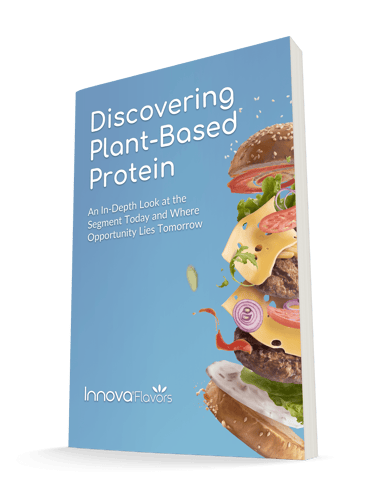Plant-based food is growing nearly two times faster than total U.S. retail food sales. New data from SPINS and The Good Food Institute shows the segment grew 27% last year as sales jumped from $5.5 billion in 2019 to $7 billion in 2020.
Last year, more than 290 million units of meat alternatives were sold, a unit increase of 36 percent. Plant-based meat sales now account for 2.7 percent of all dollar sales for retail packaged meat. The category rose from $962 million in 2019 to $1.4 billion in 2020, according to SPINS data.
As interest in plant-based food continues to rise, so too does consumer expectation around taste and texture. Taste is the No. 1 driver in purchasing habits, meaning if a brand’s products don’t taste as good as they expect they will spend their dollars elsewhere. That’s why taste is your competitive advantage.
Plant-Based Flavoring Agents
At Innova Flavors, we live and breathe meat and savory flavors. It’s our passion. And because of that, we want to share with you four tips on plant-based flavoring and how to make meat alternatives taste amazing.
Tip #1: Don’t Overcomplicate the Process
Soy, pea, and wheat are used by many plant-based meat producers as the main ingredient to create substrates. Each plant species has a unique composition of protein types and what we buy in the grocery store is a complex mixture of many types of protein. Popular, synergistic combinations include pea and potato; chickpea and rice; and soy and wheat.
The biggest challenge in plant-based protein product development today is overcoming the unwanted or off-flavor that comes from plant protein sources. For example, a beany soy flavor or bitter pea protein flavor can deter customers from purchasing plant-based products.
Don’t worry too much about the off-notes your substrate leaves behind because we can fix that with maskers and flavor. But keep in mind that if your base has a green or fishy taste, it would be easier to pursue a seafood application rather than overcomplicate the flavoring process by choosing a pork application, for example.
Tip #2: Mask Before You Flavor
If you’ve read our blog about flavor maskers – Understanding Flavor Masking Agents: 5 Things You Need to Know – you have background knowledge on when to use a flavor masker. If you haven’t, know that most substrates require the use of both flavor and a masker, especially when it comes to plant-based protein.
Flavor maskers need to be custom developed to neutralize or mask off notes of your substrate. There is no single solution to masking, so sharing your base with your flavor partner is key to removing those undesirable notes and creating a mouth-watering flavor.
At Innova Flavors, we recommend masking before you flavor as maskers change the taste perception of the product and act as a neutralizer so you can start with a “clean” base. You don’t want to remove or mute the target flavor profile you worked so hard to achieve by flavoring first! Masking can also help lower the amount of flavor needed because you aren’t solely depending on flavor to mask the off-notes.
Tip #3: The More Flavor the Better
While we just told you that maskers help reduce the amount of flavor needed, it’s important to note that you will need to use more flavor to get the desired profile across with plant-based protein than with animal-based. Remember, the flavoring process is how you achieve a competitive advantage, so it’s vital that your plant-based burger tastes like an animal-based burger if that’s what you’re telling customers.
When working with a plant-based substrate, the characterizing protein flavor has to come from flavoring. For example, if you want a plant-based food product to taste like chicken, the entire “chicken” experience can only come through flavoring. Soybean will never taste like chicken without flavoring.
The production process also plays an important role in flavoring. Knowing what a plant-based product endures from start to finish will ensure lasting flavor. For example, if the product will be fried at a high temperature before consumption, more flavor needs to be used to allow for some to be lost in that process or the flavor needs to be protected so it releases when needed and not before.
Tip #4: Liquid vs. Powder Flavor
Because the chemistry of plant-based protein requires a higher level of flavor usage, concentrated flavoring is the most cost-effective way to flavor your product as a little goes a long way. In its concentrated form, a flavor is stronger and more easily amplified than alternative methods.
However, powder flavoring can also be used in plant-based protein and is more storage-friendly. Our flavorists say when it comes to liquid versus powder, it really depends on the customer’s base and how the flavor will be added which is why it’s vital to have close collaboration with your flavor partner throughout the plant-based flavoring process.
Here at Innova Flavors, we have been working in the plant-based category since 2003. We are meat and savory flavor specialists, delivering authentic vegan flavors, and have an experienced technical team who can develop customized solutions for your unique substrate and processing parameters.
Schedule a call with your Innova Flavors representative to be further guided through the plant-based flavoring process and learn how we can help your meat alternative taste amazing!

